#4 – Février / February 2022
About Afterlife
An exchange between Victor Burgin
and Alexander Streitberger
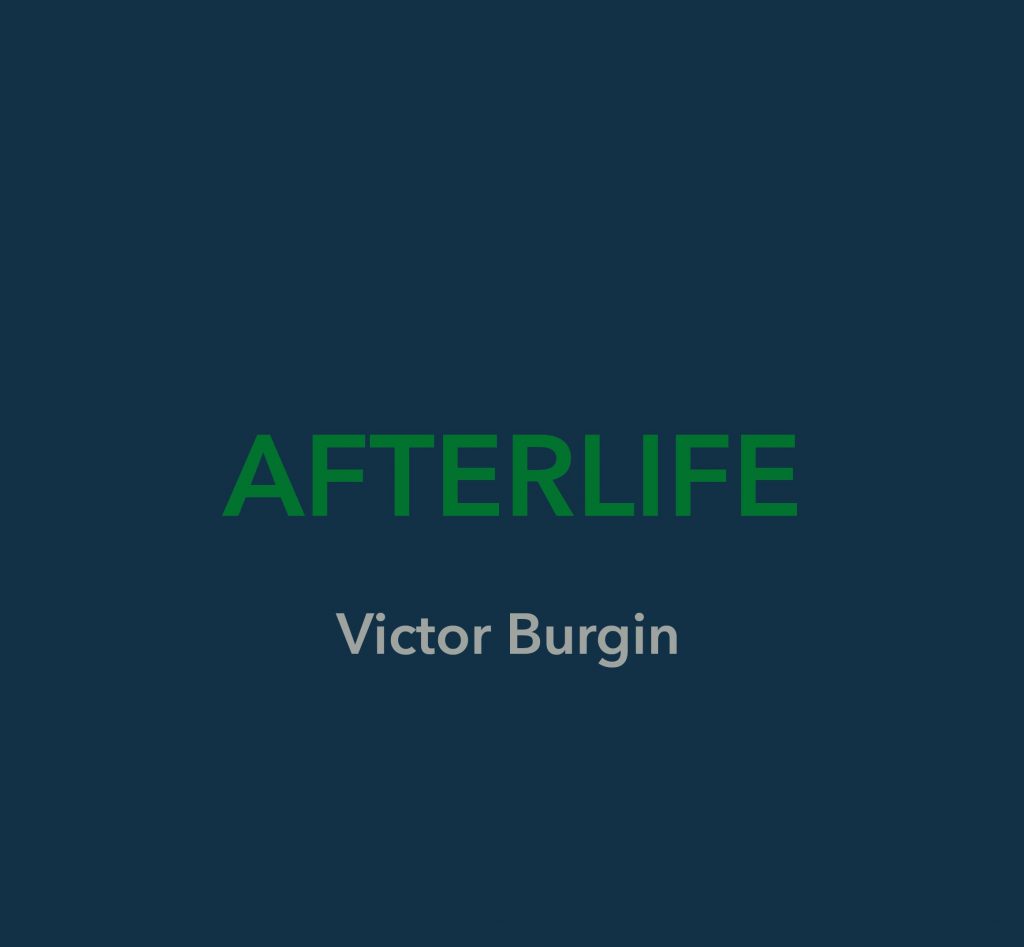
Alexander Streitberger: After having dived into Afterlife again during the last days, I think it would be best to move from the general to the specific and start with framing or situating your latest book works before going deeper into particular themes and aspects of these works (and your work in general): Two of your most recent artworks, Mandarin (Juxta Press, 2019) and Afterlife (Thomas Zander and Walther König, 2019), are books. At first glance, this seems surprising: Apart from a few exceptions, such as Family (1977), Hôtel Latône (1982), and the book adaptation of your 1993 video Venise (1997), the genre of the artist’s book has never played a significant role in your work. Moreover, the physicality of the book seems to be at odds with your projection works which consist of immaterial moving images projected on a wall or screen. How did the decision come about to produce these works in book form? How are they related to your earlier works and to what extent do they express your current concerns about what you recently called “our fractured everyday existence in algorithmic society?”1
Victor Burgin: To begin to answer those questions I have to go back to the 1960s. The 1969 exhibition When Attitudes Become Form has come to be seen by many as somehow encapsulating what ‘Conceptual Art’ was all about. In fact that show brought together some profoundly contradictory tendencies. The heterogeneity of the works in that exhibition has allowed revisionist critics and historians to define conceptualism according to their own agendas, and to suppress what was most politically radical in so-called conceptualism – the rejection of the commodity form and the object that supports it. The 1970 MoMA exhibition Information was much closer in inspiration to the impulse of conceptualism as I understood it, and prescient in its anticipation of the information age to come, an age of dematerialisation of objects – two good reasons why, in an art world dominated by material wealth and commodification, the Information exhibition has been exiled to the outermost margins of contemporary art history. My own contribution to When Attitudes Become Form, the work Photopath, took its essential form in information – as a set of instructions typed on a filing card. The virtual object specified in the instructions may be realised in an indefinite number of real contexts. The material realisation cannot be separated from the context for which it is made, and therefore cannot become a tradeable asset. I subsequently resolved the question of whether the ‘work’ was the written instruction or the photographic realisation by doing away with any material other than writing. The purely written pieces, recursive lists, could be disseminated by whatever means available: sent by fax, printed in a journal, etc. My subsequent use of computers, and the arrival of the Internet, threw such long-established issues of immateriality and ease of accessibility into sharp relief. I became uncomfortably aware that there was no reason in principle why a work made on a computer should leave the virtual space in which it was created – no reason in principle why I should not simply put my work on the Internet. In practice, however, I was inhibited from doing this for three main reasons. First: on the one hand, to fail to do so would be to ignore the specificity of the context; but, on the other hand, I was disinclined to embrace this context to the extent of producing ‘web art’. Second: the noisy environment of the Internet is anathema to the contemplative attitude my works solicit. Third: my works are usually conceived with a gallery space in mind, and all that this implies – not only the peripatetic behaviour typical of visitors, which I’ve spoken about at length elsewhere,2 but also the very event of going to see the work in the first place. Nevertheless, having as it were ‘set myself a challenge’ I collaborated with a web programmer – as opposed to a web designer – to create a neutral space in which to situate Afterlife. This satisfied my feeling, both logical and ethical, that the work should in principle be offered free of charge. To this extent it was something of a symbolic gesture, as I had no real intention of continuing to work in this way, but it also gave me the idea that I might begin to think of Afterlife as an extended work realised across different registers. To say what I mean by this I’ll give a short history of the two 2019 books you mention. In 2016 I accepted an invitation from the Italian scholar and publisher Gabriele Guercio to contribute to a series of artists’ books on the common theme of the ‘afterlife’. My response to the project subsequently outgrew the proposed limited edition format and was eventually published in 2019 by Thomas Zander/Walther König as Afterlife. As you know, Afterlife consists of passages of images and texts circling the core premise of a parallel world in which technology provides perfect digital copies of individual minds. As stated in the opening pages: “Once the duplicate is made, there are effectively two beings: one organic, the other numeric. Each evolves separately but only one will die.” This science fiction scenario serves me as an allegory of ordinary everyday life understood as a continual work of transaction between material reality and the virtual realities of memory and fantasy. In the course of producing the web-based version of Afterlife it occurred to me to think of it as an open project to be expanded upon in further works that function both independently and as satellites of the original premise. My book mandarin, published concurrently with Afterlife by Guercio’s Juxta Press, was the first of these. My exhibition Young Oaks, at the Cristin Tierney Gallery in New York last year, was the second. It occurred to me only afterwards that I had ‘discovered’ a form of practice already well-established in the mainstream media, the practice of ‘transmediality’ in which a ‘single’ story may be distributed across disparate media platforms – for example, comic book / film / videogame. I came across an interview somewhere in which a screen writer with many decades of experience of the film industry said that in the early days of his career he would pitch a story; then came the era of sequels and he would pitch a character. Now, he said, he has to pitch a world. I think of Afterlife as a world in which any number of possible works, possible stories, may emerge. Of course, in the passage from the general ‘premise’ to a particular material realisation there are considerations of specificity to be taken into account. The book invokes very different relations to the body from those usually called on in the gallery. The book is held in the hand and experienced in the act of turning the pages. Having first decided on the physical dimensions, I consider the overall rhythm of the reading experience. Essential to this are the spaces between elements, which I think of in terms of the Japanese concept of ma. The ma is the interval, both spatial and temporal, between two successive events – an interval charged with the meaning produced in this succession. I work with attention to the ma between two psychological events: the image formed while reading the text, and the image formed while looking at the picture.
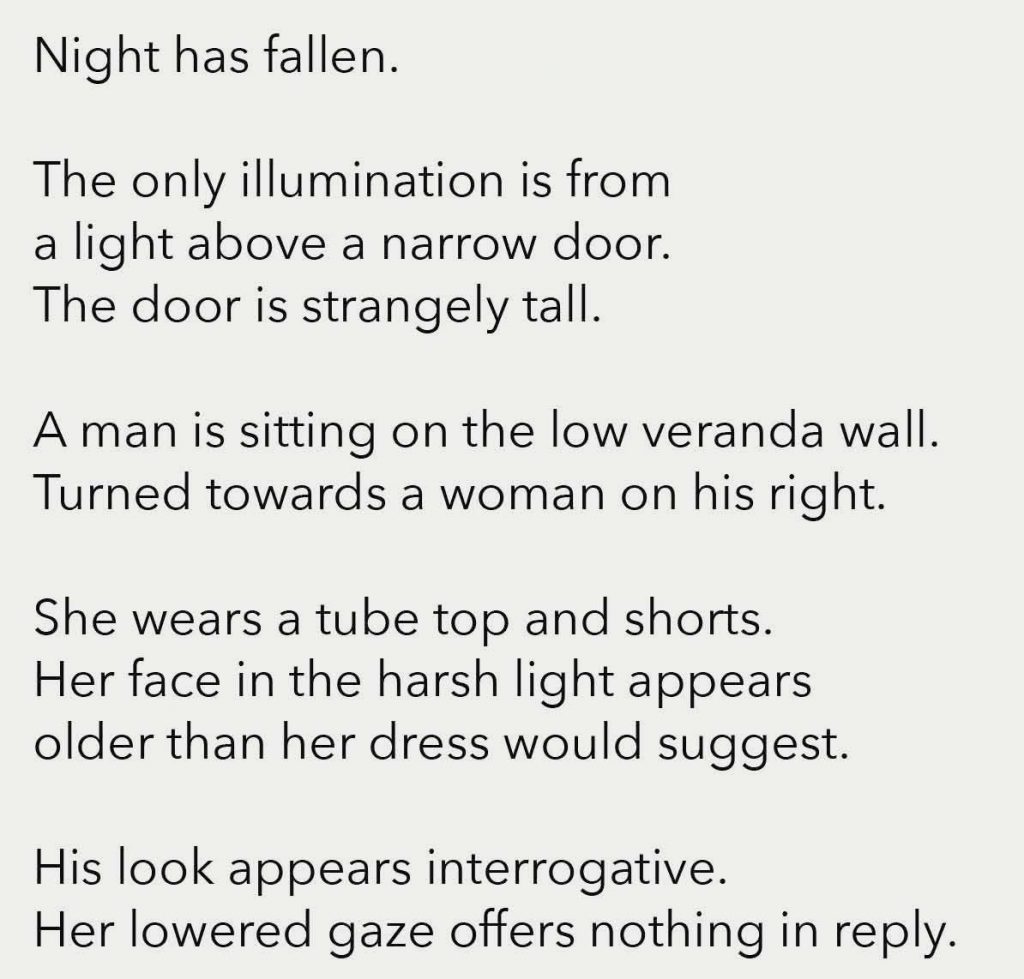
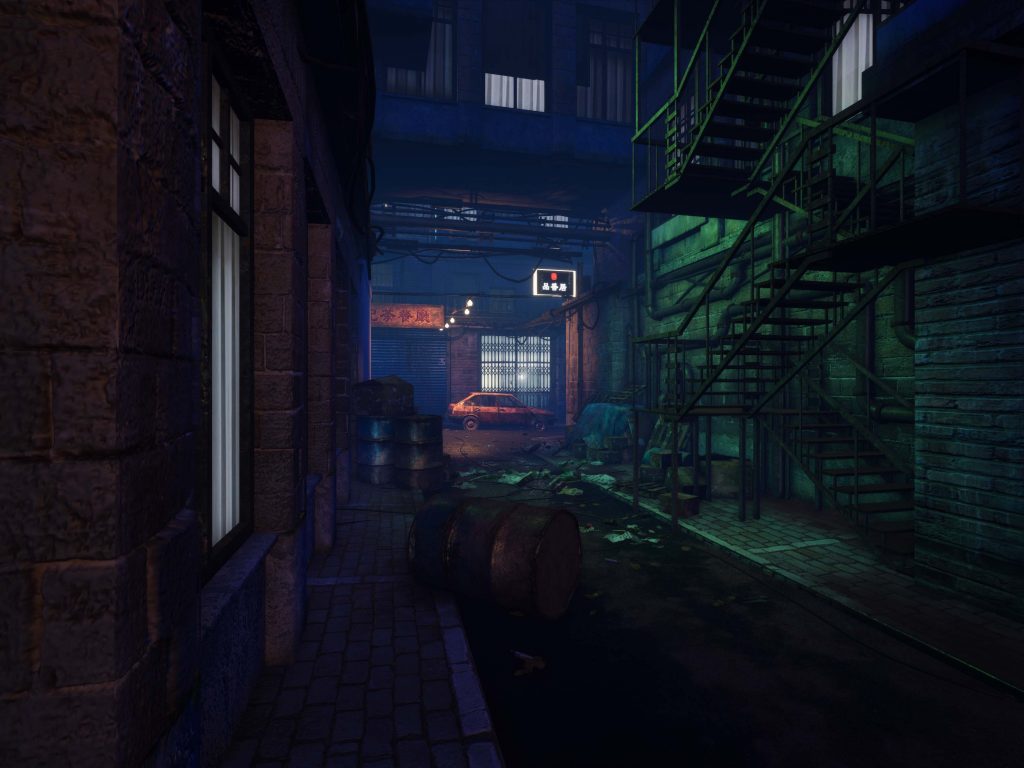
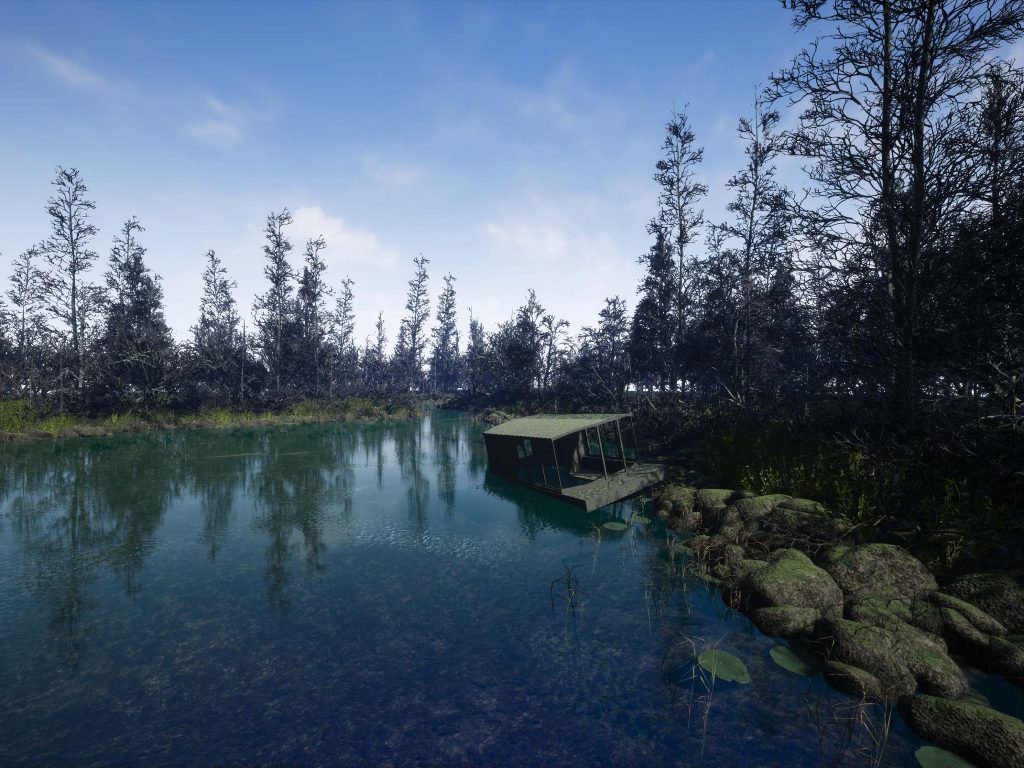

AS: This leads us to the relationship between the textual and the visual. On the one hand, some texts in Afterlife are inspired, more or less directly, by different kinds of pre-existing images. For example, on two occasions you use the rhetorical device of ekphrasis when you describe paintings by Edward Hopper and Vilhelm Hammershøi. On the other hand, certain images have their origin in novels, such as the two views of a gloomy neighbourhood full of debris and damaged cars, suggested by a scene from Asli Erdogan’s The City in Crimson Cloak (1998). Still other images are derived from visual sources – I think of the half-submerged shantyboat, paraphrasing a photograph from Alec Soth’s book Sleeping by the Mississippi (2004), or the images with the tower, which you tell me is the former control tower at La Guardia airport in New York, but which also might refer to ‘Il Fungo’, the water tower situated in the EUR district of Rome, that appears in the beginning and in the final sequence of Antonioni’s film The Eclipse (1962) a film you say you had in mind while making your projection work Solito Posto (2008).3 And, finally, some texts condense the plot of novels, such as Adolfo Bioy Casares’ The Invention of Morel (1940) which – like Afterlife itself – deals with the fantasy of the mind’s separation from the organic body. So, if your work can be described in terms of ‘transmedia’ because of its dispersion across multiple media forms such as the book, the Internet, and the gallery space, it may also be defined in terms of intertextuality and intermediality, for it interweaves various stories, texts and contents which are constantly migrating from one medium to another – from literature to photography, from cinema to computer images, from painting to text, and so on. Christine Berthin aptly compares your use of language with Thomas de Quincey’s definition of the palimpsest, as a process of piling “everlasting layers of ideas, images and feelings”.4 Would you agree to extend the concept of the palimpsest to your whole work and the way it interrelates different media and sources? And to what extent does this idea of a ‘palimpsestic’ practice meet your conception of the artistic work as the representation of a psychical object?
VB: Certainly, ‘palimpsest’ is an appropriate idea to invoke – not least, when speaking of the relationship between word and image. Think of a pedagogic book for small children. There on the page is a picture of an apple, and underneath the picture is the word ‘apple’. This is how we are taught to read, and in the process of being taught to read we are taught that there is a perfect complementarity between word and image. The word ‘says’ and the image ‘shows’ the same thing. This is the concordant relation of writing to the photograph in journalism, and documentary practice in general. The fact of this universal early pedagogy is the reason I should not have been quite as surprised as I have been on the occasions when someone has looked at my work and said to me: “I don’t get it, the words don’t go with the images!” Your mention of the ‘psychical object’, perhaps by association with childhood again, leads me to think now of that passage in La Chambre Claire where Roland Barthes invokes the scene of an infant pointing a finger and babbling “Ta, Da, Ça!” The adult knows the child means “That!” but cannot know what ‘that’ is for the child. I have a childhood memory, I must have been about five-years-old, of looking out of a window at home across a valley given over to the steel industry. On the line of the horizon are a number of triangular forms. Showing off some recently acquired knowledge, I point to them and tell my mother they are pyramids, and the land over there is Egypt. She tells me that the peaks are slag heaps, and the ‘land’ over there is Tinsley – a neighbouring district in the city of Sheffield where I grew up. Egypt is not effaced in my enhanced grasp of geography. The pyramids still shimmer in the haze, along with drifting clouds of smoke and steam, my mother’s presence, the quality of the light, bodily sensations, percussive sounds from factories, memories and anticipations, the words ‘Egypt’, ‘Tinsley’, and the images these words in turn evoke – all contributing to a kind of complex object that is just there, and of which I myself am a part. I might point to ‘that’ but how to represent it? This ‘that’ is part of what I mean when I speak of a ‘psychical object’. At the end of my 1987 essay ‘Geometry and Abjection’ I call for a ‘psychical realism’ in respect of this object5 – a realism radically different from the concordant representational forms familiar from illustrative painting or documentary photography – and in this connection I speak of ‘psychical reality’, which in retrospect I now feel I should qualify by clarifying what I mean by the term. In the 1893 ‘Preliminary Communication’ with which Breuer and Freud introduce their book Studies on Hysteria we encounter their famous formula: “Hysterics suffer mainly from reminiscences.” They had concluded that at the origin of neurotic symptoms is the repressed memory of a traumatic event. By the time of his book of 1900 The Interpretation of Dreams, however, Freud had found that an imaginary event could play as much a role in the etiology of hysteria as that of a real event. This is the point at which Freud uses the expression ‘psychical reality’ to emphasise that fantasies possess a psychical reality that is independent of, even opposed to, material reality, but which nevertheless may exert all the force of a real event. For example, a neurotic may be tormented by feelings of guilt for which there is no objective reason in actual reality, but which may be perfectly justifiable when related to the unconscious fantasy which gives rise to them. This is the more rigorously clinical sense of the expression as it figures in Freud’s work. I use it less rigorously – as it were, ‘depathologising’ the idea in order to emphasise the role of unconscious fantasy in our encounters with everyday reality. To think of the routine fact of seeing the world through a filter of unconscious fantasies would be another way of understanding the term ‘palimpsest’ in this context. As you mention my evocation in Afterlife of one of Aslı Erdoğan’s novels I can say more about this to illustrate some of what I mean. I first came across her writing in 2009, when I was doing research towards my 2010 projection work A Place to Read. When I was invited to make a work in Istanbul I prepared by informing myself about the city, and about Turkish history and culture in general. I watched as many Turkish films as I could find, and read a good number of Turkish novels in translation. I made several trips to Istanbul, staying for more or less long periods of time and learning from conversations there. Over a period of months a complex of interrelated facts and impressions came to form the necessary imaginary space within which the outlines of a work might emerge. One of the figures that came to occupy this space was that of the Turkish writer in exile. Amongst the most recent and prominent embodiments of this figure is Aslı Erdoğan, who today lives in exile in Berlin. Of all the Turkish works I read in translation in the course of my research, her early novella The Miraculous Mandarin made the most lasting impression on me. While looking on the Internet for more of Erdoğan’s work I came across a photograph of her sitting and writing at a French bistro style table in what appears to be the lobby of a large hotel. Erdoğan wrote The Miraculous Mandarin while she was living in Geneva. Like the author herself, her female protagonist wanders the streets of the city by night. Early in the story she describes how she is in the habit of going into one of the cafés or bars that stay open into the early hours, ordering a coffee, and writing. I associated this scene from the novel with the scene in the photograph; then, in one of the intertitles in A Place to Read, transposed it to a café terrace in Geneva – in what is in effect an ekphrasis of the photograph I found on the Internet. In one of the images in A Place to Read I show the bistro table, but now transposed to the interior of the Istanbul coffee house. These are processes of ‘displacement’ and ‘condensation’ that Freud describes as belonging to the unconscious mechanisms at work in the formation of dreams. While I was working on Afterlife the scene of the death of the writer in Erdoğan’s novel The City in Crimson Cloak came to mind. I wrote a brief description of it, which I placed on the page immediately preceding the two images to which you refer. Although there is no literally unambiguous relation between the text and the images, the connection may easily be made, with the difference that those who happen to be familiar with the novel will know that the writer’s murder takes place on a street in Rio – again, a transposition, or in Freud’s description of the ‘dreamwork’, a displacement. The original scene in the Internet image of the woman writing at a table is broken up and its elements distributed amongst the other fragments that make up my two works A Place to Read and Afterlife – works separated in time by a decade. In a psychoanalytic view, I may suspect that at the origin of the ‘not shown’ photograph of Aslı Erdoğan is the not known of my unconscious investment in it. I may suppose, at least theoretically, that the image of Erdoğan received an emotional charge displaced from a repressed idea, which then invested other elements of the work – as it were, binding them together. I do not believe that the psychical processes I have described are peculiar to either my own individual work or to the production of artworks in general. It is simply the way the mind works. It is in the interests of inhibiting such potentially disorderly processes – processes nevertheless generative not only of poetic texts, but also philosophical or historical works – that we are drilled from our earliest years into fixing the word ‘apple’ onto the picture of the apple.
AS: You mention how interrelated facts and impressions form an imaginary space within which a work might emerge. In your recent work, this imaginary space is also a space within which moving and still images meet in a way that reminds me of the kind of mythical space evoked in Richard Wagner’s opera Parsifal – on which you based your projection piece Parzival (2013) – and Jean Cocteau’s film Orphée (1950) that updates the classical Orpheus myth on which, as you mentioned, Afterlife is anchored. In Cocteau’s film, Orpheus asks his companion, who guides him into the Underworld, why he feels he is making his way against a wind although the leaves of the trees are not moving at all. This paradox of movement and stillness can also be found in Wagner’s Parsifal, when the boy observes that although he scarcely moves he seems to travel far, to which Gurnemanz replies that “time here becomes space.” Both, Orpheus and Parsifal encounter a similar paradoxical coexistence of stillness and motion while entering a passageway that leads from real space to mythical space (respectively, the Underworld and the area of the Holy Grail). In both cases, time is in a strange way arrested or slowed down, being finally swallowed up by space. In Afterlife, this mythical space, suspended between motion and stillness, is evoked in the following passage: “The long hair of a woman / who is crossing the parking lot / is lifted and tossed as if by strong wind. / The leaves on the trees are motionless.” Is it this kind of mythical space of Cocteau’s Orphée and Wagner’s Parsifal that you had in mind when you wrote these lines? Does Afterlife suggest that this mythical space has now migrated into the virtual sphere of a purely digital universe in which contradictory temporal and spatial realities coexist?
VB: It is interesting you should make those connections, but although those scenes are familiar to me they were not on my mind, at least not consciously, at the time I wrote that short intertext. I agree with you, though, about the migration of ‘impossible’ fictional spaces into the everyday experience of virtual computer space. When I wrote those lines I was in fact thinking of the physics of the world of the 3D modelling program I was using to produce the images. As you know, the ‘afterlife’ of Afterlife is a digital simulation. The world of Afterlife therefore is bound by laws other than those of everyday material reality. In the real world, the hair of the woman in the parking lot, and the leaves on the trees, would both respond to the same compressions and rarefactions in the atmosphere. But there is no more atmosphere in a CG world than there is on the moon. If the first men on the moon had wanted their US flag to appear to flutter in the breeze they would have had to find some mechanical way of achieving this. In the world of Afterlife, hair and leaves would similarly have to be independently animated. It is as if the person creating the scene of the woman in the parking lot had become tired after programming the animation of her hair, and gone off to take a break before working on the leaves. Gravity, of course, must also be simulated, just as the behaviour of objects when they collide must be programmed. These kinds of simulations, by definition, aim to reproduce the appearance of how objects behave in the real world. But there are other aspects of the CG world that have no counterpart in reality. For example, it must be decided whether a plane will have two faces – obverse and reverse – or only one. Imagine you are moving in virtual space towards a wall. You get closer, closer, and then, when very close, you are either deflected away from the wall, or you pass through it. This is the first condition of the wall – either ‘collision’ is turned on in the programme or it is switched off. If collision is off then you simply pass through the wall as if it were not there. Now suppose that, having passed through the wall, you turn to look back. Videogame designers, and therefore the designers of the programmes used to create videogames, must be closely attentive to the demands made on the computer CPU [Central Processing Unit] – too many demands and the game will slow down. If the player of the game will never see the other side of the wall, then there is no reason to require the computer to draw it. If the wall has been created as a plane with two faces, and you pass through it, you will see the wall you just passed through. If it has been defined as possessing only one face then you will see nothing. The wall exists when approached from one direction, but ceases to exist from the other. Obviously, there is no equivalent of such an object in reality, and it makes no sense to speak of ‘simulation’ here.
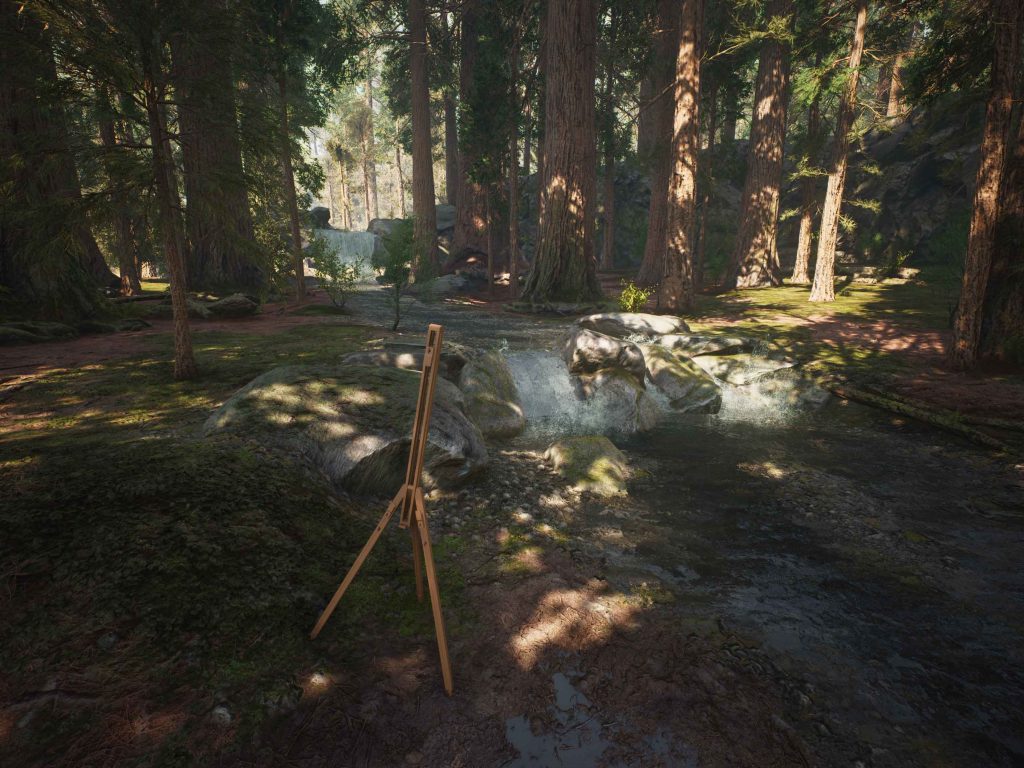
AS: So in a way, the scene of the woman in the parking lot hints at the discrepancy between the physics of nature and the physics of a computer generated world. This discrepancy becomes also apparent in a passage of Afterlife where you describe the default geography of the island as “a conglomerate of widely divergent ecosystems and terrains.” Similar contrasts can be observed in the image sequences. For example, when the representation of a gloomy industrial cityscape is followed by two breathtaking views over mountain chains. Furthermore, a temporal paradox is introduced in the two images of a burning car in which the ‘natural’ chronological order is reversed by the fact that the first image shows the smoke provoked by the jet of flames flaring up in the second image. Some pages further on, we discover an easel set up by a stream in a forest. This image seems crucial to me because it overtly refers to landscape painting. Traditionally, landscape painting is based on the illusion of providing a view of naturally given topographical scenery. But since its beginnings it has never been a pure copy of the real world but a montage of diverse segments of nature that rather represents an ideal landscape. According to the late 18th century concept of the ‘picturesque’, the idea of landscape is formed by and in representation. In the same period, aesthetic categories such as the beautiful and the sublime further emphasized the representational character of nature. I have the impression that the depictions of nature in Afterlife stand in this aesthetic tradition of landscape painting, except that the sources of these computer generated landscapes are not to be found in nature itself but in painting. Already in the late 1990s, Lev Manovich observed that “what computer graphics has (almost) achieved is not realism, but photorealism – the ability to fake not our perceptual and bodily experience of reality but only its photographic image.”6 In the case of the mountain views in Afterlife, it seems that these two representational layers overlap: the photorealistic feeling and the tradition of landscape painting. How did you make the landscapes reproduced in Afterlife? Are they referring to specific pictural or literary sources? Would you agree if I suggest that the confrontation of images of perfect, apparently untouched, nature with dystopian views of industrial zones and burning cars can be understood as a response to the contradiction that, today, digital technology and computer graphics are used to simulate ideal ersatz worlds while the destruction of our natural environment constitutes an increasingly pressing threat?
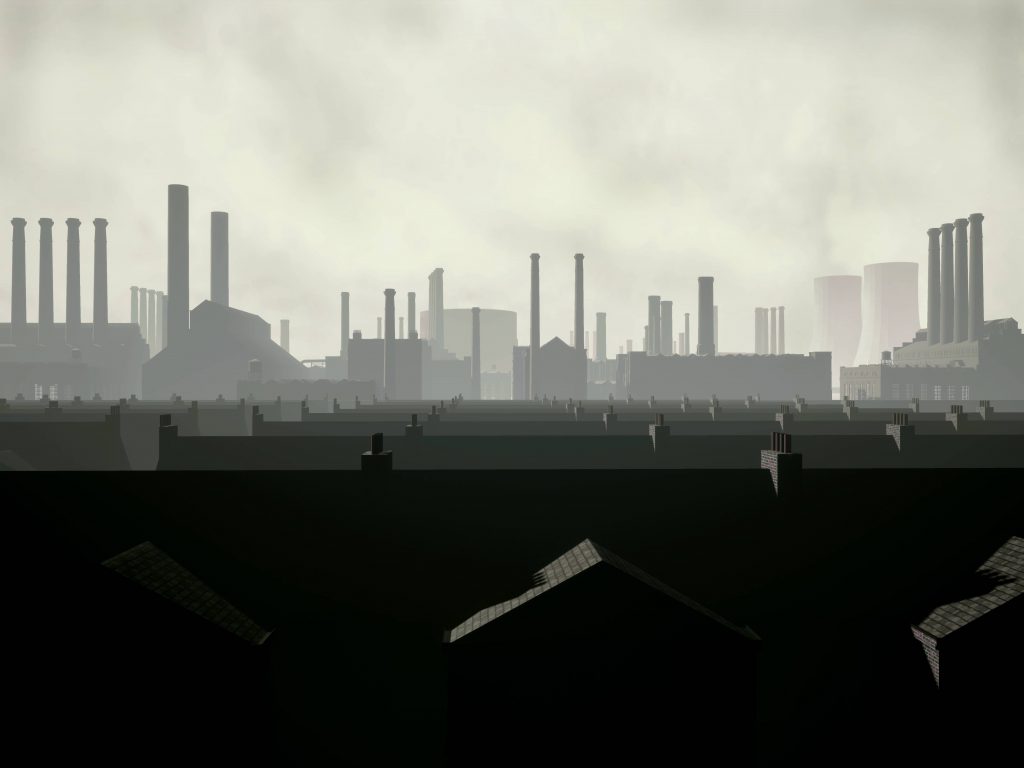
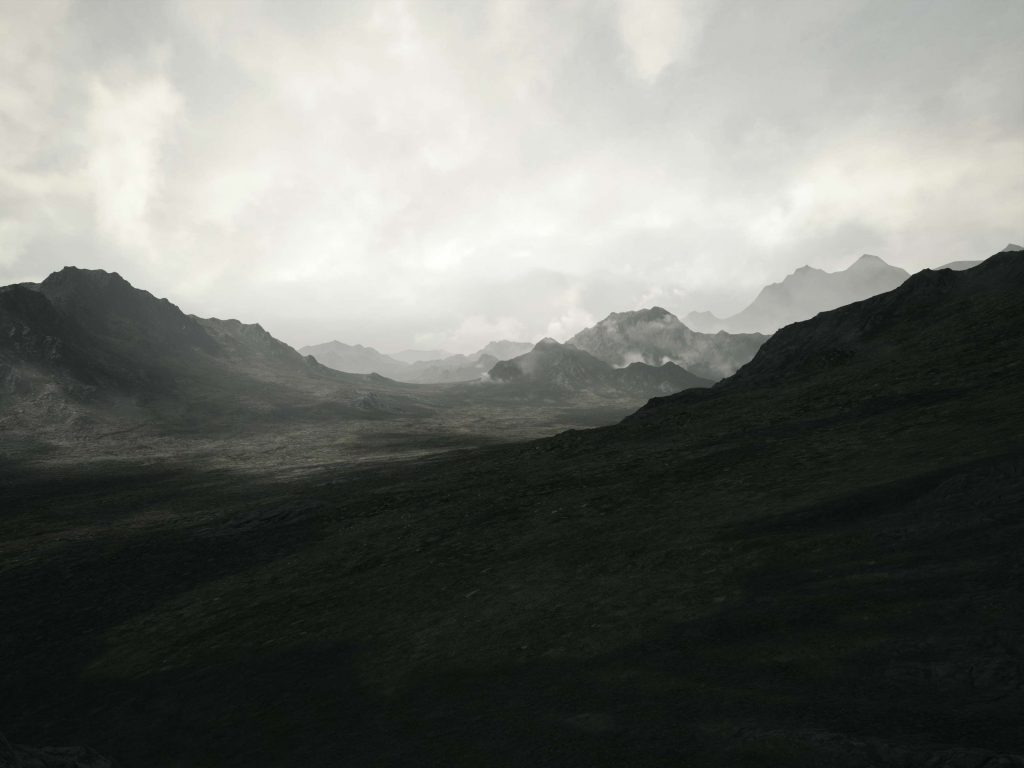
VB: You raise a number of questions. I agree that computer graphics simulate not the way the world appears in reality, but rather the way the world appears when photographed and filmed. The holy grail of CGI programmers is ‘PR’ – photorealism. They also use the acronym ‘NPR’ for non-photorealism. Enormous programming resources are poured into providing virtual cameras with the defects of physical cameras; for example, by reproducing the effects of spherical and chromatic aberration – linear distortion and colour fringing – that unavoidably afflict glass lenses, but which have to be laboriously programmed into the definition of their digital counterparts. The requirements of photorealism of course also extend to the objects in front of the virtual camera. This is certainly true of representations of landscape. Although there are occasionally deliberately cartoon-like renderings of such things as trees and rocks, for the most part such elements are produced by photogrammetry – by means of a composite of multiple photographs of the real thing. There are individuals, and more or less large companies, who produce such landscape “assets”, as they are called, for sale to individuals like myself, and to such other clients as architectural firms and film production companies, for incorporation into their virtual sets. Once the preconstructed landscape has been imported it can be modified within the game engine: for example, one can delete or add foliage or rocks or water, one can change the form of the hills, one can change the lighting to any time of day, and the weather conditions. There are also occasions when, rather than modify a bought asset, one has to build the landscape, literally, from the ground up’ – which is what I’ve had to do for the piece I’m working on now, where I was unable to find a suitable point of departure in the market place. Certainly, landscape painting is an early and enduring interest of mine. As a viewer is always-already implied by a system of representation, and especially by a perspectival system, then any landscape painting is in effect always-already the representation of a ‘figure in a landscape’. As a young art student in Sheffield in the North of England, at that time a centre of the steel industry, the landscapes I painted were predominantly industrial landscapes. The image, early in Afterlife, that immediately precedes the two ‘mountain’ views to which you refer is made from memory, by a process of combining, modifying and lighting items from assets acquired on the Internet. These two views are variations on the same bought asset. The one that appears first, directly after the ‘Sheffield rooftops’, I made with the slag heaps in mind. These are the kinds of ‘hills’ where I played in childhood. The text that comes before it is a written evocation of fragments of the ‘same’ memory. Here, of course, we must heed Freud’s caution, in his 1899 essay ‘Screen Memories’, that memories of childhood recalled in adult life may bear no direct and unmediated relationship to past events but are rather subject to unconscious transformation. As a consequence, he says, we may not have any memories from childhood but only memories relating to childhood. Nevertheless, some time after the publication of Afterlife, I was clearing out a drawer and came across a 35mm transparency of the view from the hill immediately behind my childhood home. I was surprised by how closely it corroborated the image I had constructed in software from my memory image. That view is of course part of the same industrial panorama I invoked when I talked about the ‘Egypt’ of my childhood. The easel by the stream is indeed deliberately intended to invoke not simply the tradition of landscape painting but the perspectival system of representation in general. As you know, I have argued for the necessity of appreciating the historical and ideological continuity of this system: from its origins in Classical and Medieval optics and geometry, through Renaissance drawing and painting, via the mechanisation of such manual practices in nineteenth-century photography, through to its now mathematical expression in the kinds of computer modelling programmes I used to make the images in Afterlife. The ‘figure in a landscape’ is of course – as you remark – unavoidably the ur-figure of humanity faced with the natural world, and with the question of its own being in this world. Complicating the issue is the fact that the ‘natural’ landscape is rarely innocent of the trace of human conflict. The idea of the ‘picturesque’ was elaborated in a book published in 1782 by the English Anglican cleric and artist William Gilpin. With the war with France discouraging travel to the continent Gilpin sought to instruct a sight-seeing British leisure class as to how they might find worthy subjects for their sketchbooks closer to home. For example, he wrote: “A ruin is a sacred thing. Rooted for ages in the soil: assimilated to it; and become, as it were, a part of it …”7 In Gilpin’s time ruins were appearing in increasing numbers in the British countryside. The industrialisation of the weaving trade, formerly carried out by independent family units, had forced weavers out of their cottages and into the new mill towns. The ‘Enclosures Acts’ implemented by Parliament in Westminster had allowed large landowners to convert what had previously been common lands to private ownership, compelling small farmers to leave their homes to also seek work in the towns. In the Scottish Highlands crofters who had formerly lived by raising cattle on lands maintained in common, were forced off the land to make way for sheep in response to a boom in the wool trade. The background of Jacobite rebellion against British rule provided a pretext for the ‘Highland Clearances’ to be enforced through more overt violence than was exerted South of the border, with homes burned down and whole villages forcibly deported to British colonies abroad. Eventually overgrown with moss and vines these provided ‘picturesque’ subjects for the social classes who sketched. There is almost always, in the words of the British art historian John Barrell, a “dark side of the landscape.”8
2021
1. Interview with Michael Grieve, 1000 words. https://www.1000wordsmag.com/victor-burgin/
2. Victor Burgin, Parallel Texts, London, Reaktion Books, 2011, pp. 196-197. On the peripatetic mode of spectatorship in Victor Burgin’s work see also Alexander Streitberger, Psychical Realism. The Work of Victor Burgin, Leuven, Leuven University Press, 2020, pp. 237-244.
3. See, Alexander Streitberger (ed.), Situational Aesthetics : Selected Writings by Victor Burgin, Leuven, Leuven University, 2009, pp. 331 ff.
4. Christine Berthin, ‘Pre-occupations: Calling Up Ghosts in A Place to Read and Belledonne’, in Ryan Bishop and Sunil Manghani (eds), Seeing Degree Zero. Barthes / Burgin and Political Aesthetics, Edinburgh, Edinburgh University Press, 2019, p. 334.
5. Victor Burgin, ‘Geometry and Abjection’, in Victor Burgin, In/Different Spaces. Place and Memory in Visual Culture, Berkeley, Los Angeles, London, University of California Press, 1996, pp. 39-56.
6. Lev Manovich, ‘The Paradoxes of Digital Photography’, in Hubertus von Amelunxen, Stefan Iglhaut, Florian Rötzer (eds), Photography after Photography: Memory and Representation in the Digital Age, London, G+B Arts, 1997, p. 63.
7. William Gilpin, Observations Relative Chiefly to Picturesque Beauty Made in the Year 1772, On Several Parts of England; Particularly the Mountains and Lakes of Cumberland, and Westmoreland, vol. 2, London, 1782, p. 188.
8. John Barrell, The Dark Side of the Landscape. The Rural Poor in English Painting 1730-1840, Cambridge, Cambridge University Press, 1983.